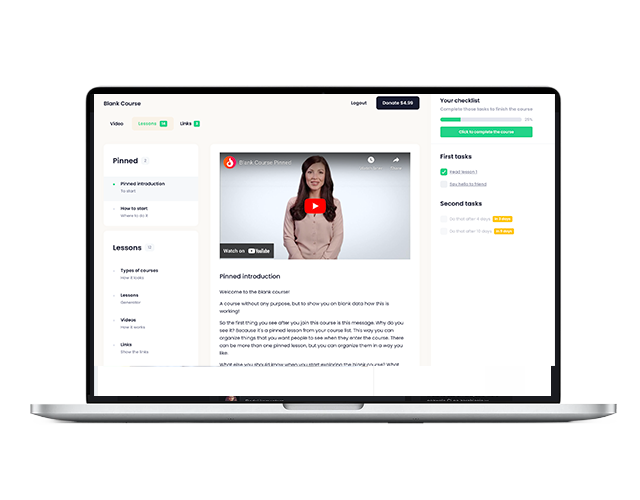How to build a perfect course
Do you want to create the perfect online course? It's not as difficult as you might think! In this blog post, we'll show you how to build a perfect course from start to finish. We'll cover everything from defining your target audience to creating engaging content to promoting your course. By following these tips, you'll be well on your way to putting together a winning online course!

Photo by Pixabay on Pexels
Defining the perfect course.
A perfect course is one that meets the needs and expectations of the students, while also providing the instructor with an enjoyable and fulfilling teaching experience. There are many different ways to create a perfect course, but there are some common characteristics that all successful courses share.
What are the characteristics of a perfect course?There are many different characteristics that can make a course perfect, but some of the most important ones include:
• A well-defined purpose and goals: Every successful course has a clear purpose and specific goals that it aims to achieve. Without this focus, it can be difficult to create an effective curriculum and keep students engaged.
• Engaging and relevant content: The best courses offer content that is both engaging and relevant to the lives of the students. This means creating lesson plans and materials that address real-world problems and challenges faced by the target audience.
• A supportive learning environment: A positive learning environment is essential for any type of educational setting, but it’s especially important in online courses where students may feel isolated. Creating a supportive community through forums, chat rooms, or other means can help reduce feelings of isolation and promote student engagement.
• Effective instructional design: Good instructional design is critical for any type of educational material, whether it’s an online course or a traditional classroom setting. If a course is poorly designed, it will be difficult for students to learn effectively and retain information over time.
Planning the perfect course.
When you're ready to start planning your perfect course, there are a few key tips to keep in mind:
1. Define your audience. Who do you want to reach with your course? What are their needs and wants? What are their learning goals?
2. Keep it focused. Don't try to cover too much ground in one course. Stick to a specific topic or skill set and build from there.
3. Make it achievable. Don't overwhelm your students with too much material or unrealistic expectations. Set achievable goals and create a timeline that works for you and your students.
4. Get organized. Create a detailed outline of what you want to cover in each lesson and module of your course. This will help you stay on track as you're creating content and will make it easier for your students to follow along.
5 .Think outside the traditional classroom model . There's more to learning than lectures and exams . Be creative in how you structure your course and what type of content you include .
6 . Plan for different learning styles . Not all students learn the same way , so it's important to include a variety of activities , resources , and assessments that cater to different learners .
7 . Make it engaging . No one wants to sit through a boring lecture or read dry , lifeless text . Keep your students engaged by incorporating multimedia , real-world examples , and hands-on activities whenever possible .
8 . Leave room for flexibility . Even if you have a well - thought - out plan , things will inevitably come up that throw off your schedule or require you to change direction mid - course . Build in some flexibility so that you can adjust on the fly without derailing the entire class .
How to create a course outline.Once you've decided on the focus and structure of your course, it's time to start creating a detailed outline. This will be your roadmap as you're creating content and will help you stay on track. Here's how to create a course outline:
1. Start with a high-level overview. Write down the main topics or modules you want to cover in your course.
2. Create a lesson plan for each topic . Once you have an overview of the topics you want to cover , start planning out each individual lesson . What points do you want to hit ? What activities or exercises will students complete ? What resources will they need ?
3 . Make it visual . A written outline is fine , but it can be helpful to also create a visual representation of your course . This could be a mind map , flow chart , or even just a simple list of lessons with bullet points .
4 . Don't forget assessments . As you're planning each lesson , think about how you'll assess student understanding . Will there be quizzes ? Projects ? exams ? Make sure these are clearly mapped out as well so that there are no surprises later on .
Creating the perfect course.
Creating a perfect course is not an easy task. There are many factors to consider when planning and designing your course. Here are some tips to help you create the perfect course:
1. Define your goals and objectives. What do you want your students to learn? What skills do you want them to develop? What knowledge do you want them to acquire? Be specific and realistic in setting your goals.
2. Choose an appropriate format. Will your course be self-paced or instructor-led? Will it be offered online or in person? Will it be asynchronous or synchronous? Consider the needs of your students and the resources available to you when choosing a format.
3. Develop engaging content. Your content should be well-organized, clear, and concise. It should also be engaging and interactive, with plenty of opportunities for practice and feedback.
4. Use assessment strategies effectively. Assessment should be aligned with your learning objectives. Use formative assessments throughout the course to give students feedback on their progress, and use summative assessments at the end of the course to evaluate their overall understanding of the material.
5. Promote active learning. Active learning is more effective than passive learning. Encourage students to participate in discussions, work on projects, and solve problems.
6. Make use of technology. Technology can be a great way to engage students and improve the overall quality of your course. Use it wisely and sparingly, however, as too much technology can be overwhelming and distracting.
7. Be flexible and responsive to feedback. No course is perfect, and you will likely need to make changes along the way based on student feedback or other factors. Be open to making adjustments to improve your course.
Promoting the perfect course.
There are a few key things to keep in mind when promoting your course:
1. Make sure you have a clear and concise message about what your course offers.
2. Create marketing materials that are visually appealing and easy to understand.
3. Use social media, email marketing, and other online tools to reach your target audience.
4. Hold promotional events or webinars to generate interest in your course.
How to market your course.
Once you've created your marketing materials, it's time to start reaching out to potential students! Here are a few ideas:
1. Use social media platforms like Twitter, Facebook, and LinkedIn to share your course information with a wider audience. Make sure to use relevant hashtags so people can easily find your content.
2. Email marketing can be a great way to reach potential students who may be interested in taking your course. You can create targeted email lists based on factors like location, age, or interests.
3. If you have an existing website or blog, make sure to promote your course on there as well! You can also submit articles about your course to popular online directories or magazines related to your industry.
Conclusion
As you can see, creating the perfect course takes careful planning and execution. By following the tips in this blog post, you can increase your chances of success. Remember to focus on creating engaging content and promoting your course effectively. With hard work and dedication, you can create a course that students will love.
